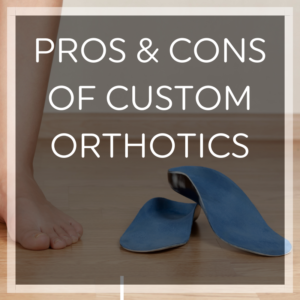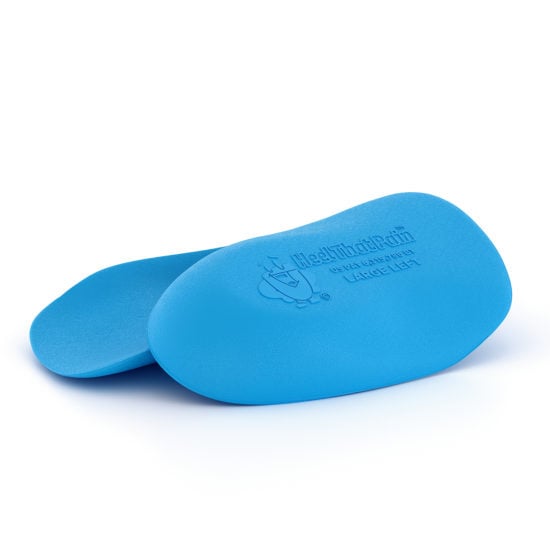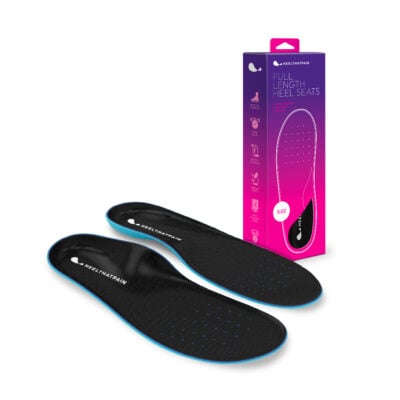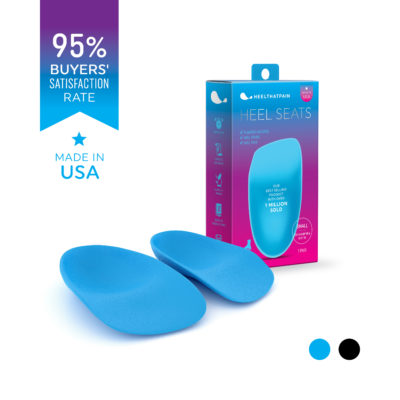What is the Fat Pad Squeeze Test?
The fat pad squeeze test is a diagnostic tool your doctor may use to rule out stress fractures and bursitis before ordering imaging scans, or making a diagnosis of plantar fasciitis.
Keep reading to learn what you should expect from a calcaneus squeeze test, when your doctor may use this test, and whether you can do this test at home.
What to Expect From a Calcaneus Squeeze Test
A calcaneus squeeze test is a very simple diagnostic tool, that can be performed in just a few seconds in your doctor’s office.
During the fat pad squeeze test, you will lie down on your stomach, with your knees flexed so that the doctor can easily examine your heels.
Your doctor will then squeeze the fat pad of your heel, using three different motions to compress the back, sides, and middle of the heel. Depending on the location and severity of pain during the squeeze test, your doctor can rule out stress fractures and bursitis of the heel, or confirm a diagnosis of plantar fasciitis.
What Your Doctor Can Learn from a Fat Pad Squeeze Test
A fat pad squeeze test can be helpful in two different ways: The test can help confirm your doctor’s diagnosis of plantar fasciitis, bursitis of the heel, or stress fracture in the heel depending on where you feel pain during the test. Or the test can help rule out one or more of these diagnoses. Sometimes initial symptoms of heel pain can present similarly, and the heel squeeze test can hone in on a more precise locus of pain and help your doctor decide whether further imagining is needed.
Plantar Fasciitis or Heel Fracture: Tenderness or discomfort when the doctor presses down on the middle of your heel indicates potential plantar fasciitis. More intense pain indicates a possible heel fracture.
Retrocalcaneal Bursitis: Pain when the doctor presses down on the back of the heel indicates likely inflamed bursa at the back of the heel, or retrocalcaneal bursitis.
Heel Fracture: Sharp pain that results from squeezing the sides of the heel is a warning sign of a heel fracture.
When Your Doctor Might Use the Heel Pain Squeeze Test
Your doctor may decide to perform a heel pain squeeze test any time you are experiencing severe heel pain that makes it difficult to walk or go about your daily activities. Fat pad squeeze tests can be especially helpful in confirming or ruling out stress fractures, in cases where a case of plantar fasciitis does not seem to be improving with conservative care.
If you have any of the following symptoms, that seem to indicate a possible stress fracture or retrocalcaneal bursitis, your doctor may want to do a fat pad squeeze test:
- Pain that gets worse the longer you are on your feet
- Pain that is extremely sensitive to the touch, on the back, sides, or middle of the heel
- Pain that improves somewhat with a long period of rest
- Pain that gets worse when you stand on tiptoe or flex your feet downward (this can indicate bursitis)
Can You Do the Fat Pad Squeeze Test At Home?
While the fat pad squeeze test might sound simple, you shouldn’t try it yourself at home. For one thing, it will be difficult (without extensive knowledge of the ligaments, bones, and tendons in the foot) to know precisely where to squeeze during each movement.
And just as importantly, without training to help you know how hard to squeeze, it’s possible that you may inflict further damage or pain on an already tender area! If your heel is extremely tender to the touch, can’t support any weight, and gets worse (instead of improving slightly) with stretching and movement throughout the day, it’s time to schedule a doctor’s appointment. You may have a stress fracture or bursitis, instead of plantar fasciitis.
Do I Need to Get a Heel Pain Test?
If your symptoms are consistent with mild to moderate plantar fasciitis, you likely don’t need a heel pain test. The overwhelming percentage (90%) of plantar fasciitis cases can be resolved simply with conservative care, at home within about 3-6 months. Get plenty of rest, ice your feet to manage pain and inflammation, stretch your feet to help improve mobility and strength in the plantar fascia, and wear orthotic inserts to realign and support the damaged fascia.
If, however, your symptoms are severe or inconsistent with mild to moderate plantar fasciitis (for example, extreme tenderness to the touch), you should make an appointment with your doctor, who may decide to perform a heel pain test.
Are Crocs and Clogs Good or Bad for Plantar Fasciitis?
 There’s no question that clogs and Crocs are amazing. We love the way they slide right on without laces and straps, softly cradle our tired feet, and take us everywhere from the beach to the grocery store.
There’s no question that clogs and Crocs are amazing. We love the way they slide right on without laces and straps, softly cradle our tired feet, and take us everywhere from the beach to the grocery store.
But we all know that the things we love aren’t always good for us. And many people have questions about whether Crocs and clogs are actually good for plantar fasciitis.
Don’t worry — we won’t tell you to toss your favorite pair of Crocs or clogs. But there are a few things you should know!
Are Clogs Good for Plantar Fasciitis?
Clogs have been around for a very long time–and with good reason! Wooden clogs were worn by the Dutch while they farmed long hours on their feet, and people around the world have adopted them since–including people who suffer from plantar fasciitis!
It’s important to remember that not all clogs are created equal. Some can be a lifesaver for painful heels, while others can actually make your plantar fasciitis worse.
Benefits of Clogs for Plantar Fasciitis
You can find a staggering array of different clogs — from lightweight trendy slippers to orthopedic clogs made especially for professionals who spend a lot of time on their feet.
The right pair of clogs can offer easy-on, easy-off casual footwear that cradles and cushions sore heels, doesn’t compress your toes while you walk, and supports your damaged arch.
Clogs designed for working professionals or orthopedic support are ideal for individuals with plantar fasciitis. Choose clogs with a thick, cushioned sole, clear arch support, and a comfortable fit that leaves you plenty of room in the toe box but doesn’t slide around while you walk.
Drawbacks of Clogs for Plantar Fasciitis
Most of the drawbacks of wearing clogs for plantar fasciitis come from choosing the wrong type of clog or wearing a shoe that doesn’t fit properly. Ill-fitting or cheaply made shoes can place additional strain on your damaged arch, or cause additional wear to an already damaged heel pad.
Avoid clogs with a hard, thin sole and opt for a cushioned, thick sole with clear arch support. You’ll also want to make sure your clogs fit properly and don’t cause your foot to slide around too much while you walk (another hallmark of cheaper fashion clogs). A comfortably loose fit in the toe box is ideal, but your heel should be cupped securely, resting below the ball of the foot when you stand in the shoe.
Are Crocs Good for Plantar Fasciitis?
Crocs, which were originally made as non-slip, waterproof shoes for boating, have quickly become a popular choice for plantar fasciitis sufferers.
Benefits of Crocs for Plantar Fasciitis
Like clogs, Crocs come in a wide number of colors, styles, and brands! Some crocs are now made especially for individuals with heel pain, while others are meant to be worn as a casual, colorful waterproof shoe.
The right pair of crocs can help protect your feet, cushion your heel, and support your arch in situations that you might otherwise go barefoot (like the beach, pool, in the yard, or on a boat).
Crocs are typically extremely lightweight, breathable, and promote circulation which can be an advantage over clogs, especially in the summertime — or for individuals with diabetes. And like clogs, Crocs have lots of room in the toe box to promote a natural, healthy gait that doesn’t compress the toes.
Potential Drawbacks of Crocs for Plantar Fasciitis
Crocs weren’t meant to be running shoes, or even walking shoes for long distances. Don’t wear them while you walk or stand for long periods of time. Instead, opt for running shoes with orthotic inserts, which will offer better arch support and cushioning.
You’ll also want to be wary of “fashion crocs,” which are typically thinner, less cushioned, don’t have much in the way of arch support, and are less structurally stable while you walk.
Make sure you choose a pair of Crocs that has a supportive heel cup, arch support, and a thick, cushioned sole (instead of thinner plastic that may bend or distort as you walk).
How to Make Your Fashion Crocs or Clogs Better for Plantar Fasciitis
Have a pair of trendy Crocs or clogs you love — that aren’t exactly compatible with your plantar fasciitis because of a hard, thin sole or lack of arch support? There’s no need to toss your favorite pair of shoes.
Just add arch support and heel cushioning with Heel Seat Wraps. These lightweight, comfortable wraps can be worn all by themselves, or with almost any pair of shoes (including open toed sandals!) to help align and support a compromised arch, and soothe a damaged heel pad.
Clogs Designed Specifically for People with Heel Pain
When looking for a new pair of clogs, your safest bet is to buy clogs that are designed specifically for people with plantar fasciitis and other forms of heel pain.
Heel Seat Clogs are the only clogs on the market that use technology that is patented and clinically proven for heel pain. The Fascia Bar sits right at the base of the heel where your arch meets your heel bone, lifting and realigning the plantar fascia ligament and providing gentle acupressure into a common pain hotspot. They also fit more snugly to the bottom of your foot than other clog designs to ensure that you constantly have the support your feet need.
If you have plantar fasciitis, clogs and Crocs can make long hours on your feet more bearable and comfortable–as long as they have the proper arch support, cushioning, and fit! That’s where Heel Seat Clogs come in! But even if your favorite pair of crocs or clogs lack arch support or cushioning, there’s still hope. Just add a pair of Heel Seat Wraps, so you can continue to wear the shoes you love without worrying about making your heel pain worse!
Pros and Cons of Custom Orthotics for Plantar Fasciitis

Whether you’ve been newly diagnosed with plantar fasciitis or have been struggling with heel pain for months, chances are you have wondered whether or not you need custom orthotics.
Let’s take a look at the pros and cons of custom shoe inserts that can help you make your decision!
Will Custom Orthotics Help Plantar Fasciitis?
A quality pair of custom orthotics can make a big difference in improving your plantar fasciitis, by supporting your arch and cushioning a sensitive, deteriorating heel pad. That’s why orthotics are one of the top-recommended conservative treatments for plantar fasciitis!
Unfortunately, just one set of custom orthotics can cost upwards of $200. Is the price worth it? Keep reading to learn more about the benefits, drawbacks, and alternatives to custom orthotics!
Benefits of Custom Orthotics
In the past, custom orthotics had to be created by a podiatrist. However, now it’s quite a bit easier to get a pair of custom orthotics without even leaving your home.
Several companies will send you a footprint imprint kit, along with a short questionnaire online, to determine where you’re feeling pain, the exact width and length of your foot, and any other particular needs you may have (e.g., correcting overpronation).
Within less than a month, you’ll get a pair of custom orthotics.
Drawbacks of Custom Orthotics
While custom orthotics can make a big difference in heel pain, there are a few drawbacks that you should know about before you decide to buy!
High Prices
One of the biggest drawbacks to custom orthotics is the high prices. For just one pair, your starting price is about $230 on the low end. While this isn’t nearly as high as many medical interventions, it is one of the highest priced conservative treatments for plantar fasciitis.
Accessibility
Because of the high prices of custom orthotics, they aren’t exactly accessible for people with a tight budget. And because of the turnaround time needed to ship you a kit, take your foot imprint, send the imprint back, plus time for creating the orthotics themselves, it’ll be about a month before they arrive at your door — which can feel like a long time if you’re suffering.
Minimal Evidence to Justify Custom Inserts
While there’s a good deal of evidence to show that orthotics can improve plantar fasciitis, there’s not much evidence to show that custom orthotic inserts do a superior job. In fact, a recent landmark meta-analysis of 20 studies shows that custom orthotics and prefabricated orthotic inserts perform pretty much identically.
So, Are Custom Orthotics Worth It?
Custom orthotics can be a lifesaver for some people, especially if you have several different foot issues you’re trying to beat. However, for most people, the benefits of high-quality non-custom orthotics, like Heel Seats are identical to custom orthotics (the main difference being that higher price tag!).
Still can’t decide? Test out a pair of 5-star, non-custom orthotics that come with a money-back guarantee (like Heel That Pain!). If you still wonder what you might be missing with a pair of custom orthotics, test drive a brand that offers a money-back guarantee (several do!). That way, you can make sure you love your custom orthotics before you get stuck with the cost. And at the end of the day, you’ll be able to rest assured that you have the best fit for your foot–and your wallet!
Alternatives to Custom Shoe Inserts
If you aren’t ready to drop more than $200 on a pair of custom orthotics, the good news is that you have some fantastic alternatives. Clinically proven orthotic inserts like Heel Seats cost about as much as lunch out on the town, which means that you can afford to outfit every pair of shoes in your closet for less than one pair of custom orthotics.
If you spend most of your summer in sandals, there’s also alternatives that can be worn with bare feet, such as Heel Seat Wraps, which lift and align the arch like an orthotic insert, but can be worn with open-toed shoes and sandals.
Have you tried custom orthotics? Tell us in the comments below — we love hearing from you!
Common questions about custom orthotics
Yes, it’s possible to order custom orthotics online. The company you order from will send you a mold kit that you can do from home to take a mold of the bottom of your foot, and then they will create the custom orthotics from that mold. However, one of the benefits of getting custom orthotics in-person is that you are working directly with your podiatrist, who can diagnose your specific foot problem. If other factors are causing your heel pain, custom orthotic inserts may not be the best treatment solution.
The best custom orthotic is the orthotic recommended by your podiatrist! Your podiatrist will conduct an assessment to determine exactly what is going on with your feet, and what the cause of the problem is. Remember, custom orthotics are not more effective than over-the-counter orthotics for most people.
Some people with flat feet have great results from custom orthotics, while others don’t notice a difference. Orthotics can provide cushioning and support to correct arch issues, but you can find supportive inserts that are non-prescription for a fraction of the cost.
For some people, custom orthotics are definitely worth the money, while for other people they are ineffective. It’s smart to try affordable, conservative treatments like Heel Seats prior to taking the plunge and investing hundreds of dollars in custom orthotics.
You can get custom orthotics right at home by ordering an online kit, or by talking to your podiatrist. If you do not yet have a podiatrist, ask your general practitioner for an in-network referral, or visit the APMA website for a list of highly qualified doctors who specialize in foot care.
How to Find a Foot Doctor Near Me
 If you’re suffering from chronic or severe symptoms of plantar fasciitis, the question, “How do I find a heel pain doctor near me?” is at the very top of your list.
If you’re suffering from chronic or severe symptoms of plantar fasciitis, the question, “How do I find a heel pain doctor near me?” is at the very top of your list.
And while that question might seem easy enough to answer in the information age, it can be surprisingly difficult to know where you should start in your search for an amazing plantar fasciitis doctor near you. Save yourself time and frustration with these helpful tips!
Tips for Finding a Plantar Fasciitis Doctor Near Me
Finding the right plantar fasciitis doctor near you is one of the most important steps you’ll take toward healing, particularly if your symptoms are severe or have not responded to conservative heel pain care.
Use these handy resources to quickly find the right podiatrist near you:
Talk to Your General Practitioner
While your GP might not be the right fit for specialized podiatric care, here or she is very likely to be connected with doctors in many different specialties, and be familiar with the experiences that other patients who have been referred to that doctor have fared!
Search the APMA
The APMA (American Podiatric Medical Association) allows you to search for a podiatrist near you, using either a zip code search or a mile radius search (since the podiatrist closest to you might have a different zip code). Using this tool also allows you to find out whether your potential podiatrist has been board certified in different specialties (like surgery), which may be important to you.
Use the APMA Search Tool to Find a Foot Doctor Near You
Check Out Your Insurance Provider Network Online
If your insurance network is choosy, and you want to make sure that the foot doctor you choose is going to be fully covered, you may want to check your provider’s online network. Most providers offer a searchable database of in-network doctors that can be narrowed by speciality and location.
Use RateMDs.com (and Cross-Reference with Google!)
The right bedside manner, and positive outcomes from other patients are (understandably!) important factors from patients. RateMds.com allows you to read reviews from patients in your area, and can help you find a doctor with high reviews. More than 2 million providers can be found on this site alone. Make sure to cross-reference your findings with Google reviews, especially when there are only a few experiences shared on RateMds.com.
Use Local Social Media
While Facebook and Instagram aren’t much help in finding a plantar fasciitis doctor, local forms of social media, like Nextdoor.com can connect you with people in your neighborhood and district. The site allows you to post questions, asking for recommendations about which podiatrist in the area comes highly recommended, or to search other people’s questions about finding a foot doctor.
What Kind of Foot Doctor Should I Look For?
In general, if you have chronic or severe plantar fasciitis, you’ll want to start by meeting with a podiatrist. He or she can help you explore many different medical treatments for your condition, and in many cases may be certified to perform surgery, should you decide on that option.
If you are pretty sure, based on your medical history and research, that you are headed toward a surgical procedure, you may want to look for an orthopedic surgeon, who will typically have additional surgical expertise — but may be more difficult to make an appointment with. Depending on your condition and the success of more conservative medical interventions, a podiatrist may refer you to an orthopedic surgeon.
Will I Need a Referral for a Plantar Fasciitis Doctor?
It can be confusing to know whether or not you need a referral for a specialist like a plantar fasciitis doctor.
For the most part, you do not need a referral to make an appointment with a podiatrist. However, you should still check with your insurance provider, since some carriers have more complex rules about coverage for specialized medical care.
Getting a referral can also be helpful in other ways. If you have had a good relationship with your family doctor or general practitioner, he or she will often be willing to send an introductory letter to the podiatrist they recommend, along with a patient history (including injuries, treatments you have already tried, and medications you may be taking).
How did you find your foot doctor? Share your experience and tips in the comments below!
Tenex Procedure for Plantar Fasciitis
 The idea of removing scar tissue to treat soft-tissue injuries isn’t new. But there is a new, minimally invasive method of scar tissue removal that’s generating a lot of buzz!
The idea of removing scar tissue to treat soft-tissue injuries isn’t new. But there is a new, minimally invasive method of scar tissue removal that’s generating a lot of buzz!
The Tenex procedure, which was created in partnership with the Mayo Clinic as an alternative to surgery, has become an increasingly popular method for resolving chronic cases of plantar fasciitis. If you’re considering the Tenex procedure for plantar fasciitis, keep reading to learn everything you need to know about Tenex!
What Is the Tenex Procedure?
The Tenex procedure is a minimally-invasive, non-surgical medical treatment that uses high-frequency vibrations and a specialized tool to remove accumulated scar tissue from a damaged tendon (or in cases of plantar fasciitis, a damaged plantar fascia ligament)..
Tenex can be used to treat many different kinds of tendon and soft-tissue injuries, including rotator cuff tendonitis, Achilles tendonitis, and patellar tendonitis (jumper’s knee). Tenex can also be used to treat plantar fasciitis. By removing scar tissue, Tenex helps restore mobility and circulation to the injury site, as well as encouraging regrowth of healthy tissue.
Is the Tenex Procedure Effective in Treating Plantar Fasciitis?
Since Tenex was approved in 2013, more than 80,000 procedures have been performed. And the results, so far, are pretty promising. Clinical studies, as well as several years of followup research on post-treatment outcomes, are impressive — although some of the clinical studies are not specific to plantar fasciitis, but rather Achilles tendonitis or rotator cuff injuries.
One study, which followed 34 patients for more than three years after their Tenex procedure, found that even 3.5 years post-procedure, 70% were still satisfied with their procedure. Another larger study, specific to plantar fasciitis, evaluated 53 patients who underwent the Tenex procedure, and found that at 6 months post-procedure, the vast majority (96%) were pleased with their results and would recommend Tenex to a friend. The same study showed that patients’ average FADI (foot and ankle disability index) score improved from 59% to 90% by 24 weeks post-procedure (100% is the best possible score on the FADI).
What to Expect During the Tenex Procedure
After you arrive for your scheduled Tenex procedure, your doctor will use local anesthesia to numb your foot.
Once your foot is numb, your doctor will use ultrasound imaging to precisely locate the scar tissue that he or she will remove with the Tenex Procedure. Your doctor will then create a tiny incision on your heel, and insert a specialized instrument (the Tenex Tissue Removal System, which has a needle-like tip) that releases high-frequency vibrations to destroy scar tissue while leaving healthy tissue unharmed.
The entire Tenex Procedure should take less than 30 minutes, and should not be painful with the local anesthesia. Once completed, your incision will be bandaged, and you will be able to leave the treatment facility (many patients can drive themselves home, but you may want to plan for a ride just in case!).
Post-Procedure Care After Tenex
Expect up to 6 weeks of total healing time that includes extra rest, NSAIDs as needed, and icing for any swelling or tenderness. Your doctor may recommend the use of a walking boot for the first one or two weeks of recovery.
After your incision has fully healed and you are back on your feet (and hopefully feeling incredible!) you’ll want to take steps to keep your feet healthy — and keep your heel pain from returning. For instance, if your plantar fasciitis was caused by the repetitive strain of long days on your feet for work, or the stress of high-impact sports, consider wearing heel cups to support your plantar fascia, and making a new commitment to giving your feet enough rest throughout the day or activity.
Benefits of the Tenex Procedure
The Tenex procedure offers some unique benefits for people who struggle with chronic plantar fasciitis, especially in comparison with surgery:
- Fast relief from heel pain following the procedure
- Shorter healing time, compared to surgery (many people recover in as little as three weeks)
- Small incision that doesn’t require stitches
- No scarring, and very few potential side effects
- Precise tool that, when used with guided ultrasound imaging, can destroy only damaged tissue while leaving healthy tissue intact
- Promising results in clinical studies
- Local anesthesia, instead of general anesthesia
- Typically covered by insurance, making the procedure less expensive
- Good alternative for patients who haven’t had success with conservative treatments, physical therapy, surgery, or cortisone shots
Possible Side Effects and Risks of the Tenex Procedure
There are very few documented side effects of the Tenex procedure, and all are minor and temporary.
As you recover, you may experience pain, redness, tenderness, or swelling in the foot that has been treated. You may also notice some bruising or minimal trauma to the treatment area. You can manage these symptoms with ice packs and NSAIDs as needed. Follow your doctor’s instructions about when to remove the bandage, rest the foot often, use your walking boot as needed, and keep the wound clean as directed for the fastest healing time.
How Much Does Tenex Cost?
The cost of a Tenex procedure will depend on whether or not it’s covered by your particular insurance company (most providers do cover the Tenex procedure), whether the procedure is performed in a hospital setting or a doctor’s office, and whether local anesthetic or sedation is used (most people just need local anesthetic).
Without insurance, Tenex can cost anywhere from $1,600-$5,000 according to representatives from Tenex Health.
What Type of Doctor Performs the Tenex Procedure?
Several different kinds of specialists are trained in the Tenex procedure, including orthopedic surgeons, podiatrists, radiologists, and sports medicine providers. You can find a provider trained in Tenex by using the Tenex locator.
Before you schedule or undergo the Tenex procedure, make sure you verify with your insurance that the procedure will be covered by your chosen provider, and find out whether or not you need a referral.
If you do need a referral as required by your insurance provider, talk to the podiatrist or general practitioner who has treated you for plantar fasciitis.
Have You Tried Tenex?
Have you undergone (or are thinking about undergoing) the Tenex procedure? We want to hear all about it. Tell us about your experience in the comments below!






